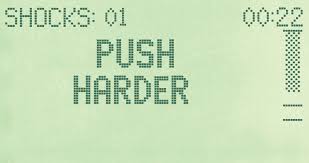Despite first class ambulance services in Australia providing an outstanding standard of care, studies have shown survival from an out-of-hospital Sudden Cardiac Arrest in Australia is at best one in ten (10%). The majority of Sudden Cardiac Arrests occur out-of-hospital. Even under ideal circumstances where the Sudden Cardiac Arrest is witnessed by bystanders, it takes time to dial triple zero (000) and provide the necessary information; it takes time to activate and dispatch the ambulance; it takes time for the ambulance to arrive at the scene; and it takes time for paramedics to arrive at the side of the victim. Despite meeting international response standards, it is not uncommon for ten minutes (in city areas – rural & remote may be hours away) to elapse from the time of the ‘000’ call to paramedics being able to commence treatment. Unfortunately, it is our experience that very few patients receive effective cardio-pulmonary resuscitation (CPR) or defibrillation prior to arrival of the paramedics, leaving the victim with little chance of surviving.
There are four key interventions that, when combined, significantly improve the likelihood of the victim being successfully resuscitated and surviving. This is known as the “Chain of Survival”.
a) Early access to the emergency response system (call triple zero ‘000’)
b) Early effective CPR to support circulation to the heart and brain
c) Early defibrillation to treat Sudden Cardiac Arrest caused by shockable rhythms
d) Early Advanced Life Support by paramedics and hospital personnel
Studies have shown effective CPR and early defibrillation are associated with significantly higher rates of survival. Survival rates can be as high as 60-80% when the “Chain of Survival” is implemented. It is known that the chance of survival decreases by approximately 10% for every minute defibrillation is delayed. This is why ready access to a defibrillator is essential if the victim is to survive.

In addition to paramedics, doctors and nurses; defibrillators have safely and successfully been used by airline flight crews, security guards, police officers, fire fighters, first responders, first aiders, community responders and members of the general public. Defibrillators are becoming increasingly common with defibrillators now located in high profile public places including airports, train stations and many workplaces.
Defibrillators are now small, safe, light weight, affordable, simple to use and require minimal training to use. All first aid courses now cover defibrillation training. Defibrillators stocked by your Defibshop all guide you through the process from the moment you turn the defib on. The defib tells you to attach pads, tells you if the victim needs to be defibrillated (shocked) and reminds you to perform CPR. This allows you to provide two of the links of the “Chain of Survival” whilst waiting for the paramedics to arrive, thereby minimising delays in providing definitive care. Paramedics know if the victim is defibrillated early, the heart is more likely to start beating normally.
Ambulance Service defibrillators and public access defibrillators are all compatible and able to be used for all Sudden Cardiac Arrests. The attending paramedics will either continue to use the first defibrillator being used, or they may change over to their unit that may be manually operated – either way the patient will still receive a shock when required.
Do you have any questions we can help you with? Call your Defibshop on 1300 729 575, or contact us here.
Defibshop – makes saving lives easy!
Australia’s No: 1 Defibrillator Store!


